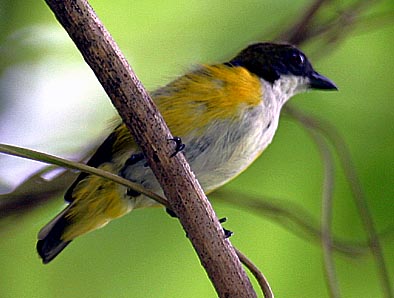(All sections expanded. References updated.) |
|||
| (4 intermediate revisions by 3 users not shown) | |||
| Line 1: | Line 1: | ||
| − | + | [[Image:Yellow-sided_Flowerpecker.jpg|thumb|550px|right|Photo by {{user|mehdhalaouate|mehdhalaouate}}<br />[[Sulawesi]], [[Indonesia]], June 2004]] | |
| − | [[Image:Yellow-sided_Flowerpecker.jpg|thumb|550px|right|Photo by mehdhalaouate]] | + | ;[[:Category:Dicaeum|Dicaeum]] aureolimbatum |
| − | |||
| − | |||
| − | |||
| − | |||
==Identification== | ==Identification== | ||
| − | + | 8·5 cm (3¼ in); a tiny flowerpecker | |
| − | + | *Bright olive-green upperparts | |
| − | + | *Paler crown | |
| − | + | *Brighter green rump | |
| + | *Blackish-brown upperwing and tail | ||
| + | *Blackish-grey [[Topography#Heads|auriculars]] | ||
| + | 3Sexes similar. | ||
| + | |||
| + | ==Distribution== | ||
| + | [[Sulawesi]] and nearby islands. | ||
| + | |||
| + | A common species in its range but most often difficult to spot. | ||
| + | ==Taxonomy== | ||
| + | ====Subspecies==== | ||
| + | There are two known geographical variations<sup>[[#References|[1]]]</sup>: | ||
| + | *''D. a. aureolimbatum'': | ||
| + | :*[[Sulawesi]], Bangka, Lembeh, Muna and Butung islands | ||
| + | *''D. a. laterale'': | ||
| + | :*Sangihe Island (off northern Sulawesi) | ||
==Habitat== | ==Habitat== | ||
| + | Primary and tall secondary forests and forest edges. | ||
==Behaviour== | ==Behaviour== | ||
| + | ====Diet==== | ||
| + | The diet is mainly small figs, mistletoe berries, pollen and spiders and small insects. | ||
| + | ==References== | ||
| + | #{{Ref-Clements6thAug16}}#Handbook of the Birds of the World Alive (retrieved January 2017) | ||
| + | {{ref}} | ||
==External Links== | ==External Links== | ||
{{GSearch|Dicaeum+aureolimbatum}} | {{GSearch|Dicaeum+aureolimbatum}} | ||
| − | [[Category:Birds]] | + | [[Category:Birds]] [[Category:Dicaeum]] |
Latest revision as of 00:23, 24 January 2017
- Dicaeum aureolimbatum
Identification
8·5 cm (3¼ in); a tiny flowerpecker
- Bright olive-green upperparts
- Paler crown
- Brighter green rump
- Blackish-brown upperwing and tail
- Blackish-grey auriculars
3Sexes similar.
Distribution
Sulawesi and nearby islands.
A common species in its range but most often difficult to spot.
Taxonomy
Subspecies
There are two known geographical variations[1]:
- D. a. aureolimbatum:
- Sulawesi, Bangka, Lembeh, Muna and Butung islands
- D. a. laterale:
- Sangihe Island (off northern Sulawesi)
Habitat
Primary and tall secondary forests and forest edges.
Behaviour
Diet
The diet is mainly small figs, mistletoe berries, pollen and spiders and small insects.
References
- Clements, J. F., T. S. Schulenberg, M. J. Iliff, D. Roberson, T. A. Fredericks, B. L. Sullivan, and C. L. Wood. 2016. The eBird/Clements checklist of birds of the world: v2016, with updates to August 2016. Downloaded from http://www.birds.cornell.edu/clementschecklist/download/
- Handbook of the Birds of the World Alive (retrieved January 2017)
Recommended Citation
- BirdForum Opus contributors. (2024) Yellow-sided Flowerpecker. In: BirdForum, the forum for wild birds and birding. Retrieved 28 May 2024 from https://www.birdforum.net/opus/Yellow-sided_Flowerpecker




